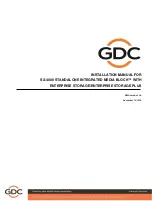
42
5.11A External Word Clock Reference
The AI-2 sample rate and time code are derived from an external
word clock present at the W/C in connector and one of the three
"secondary" frame reference signals described below, Lynx
synchronizer, video or internal.
Word clock by itself does not contain frame information so the AI-2
will derive its frame rate reference by bringing its time code frames
into alignment with one of the secondary references. For this
reason three word clock reference selections are provided.
When operating with an external word clock reference, IT IS
ESSENTIAL THAT THE EXTERNAL WORD CLOCK AND FRAME
REFERENCE ARE SYNCHRONIZED TO EACH OTHER. If this is
not the case, then program material recorded on the ADAT will drift
relative to time code. For this reason, THE W/C IN CONNECTOR
SHOULD BE USED WITH CAUTION.
5.11B Lynx Reference
The AI-2 sample rate and time code are referenced to a special
frame reference signal, provided for the AI-2 by the synchronizer, at
the LYNX-2/MICRO LYNX connector.
This signal ensures that the AI-2 will always be correctly synchro-
nized with the frame reference of the synchronizer system. If the
synchronizer system reference is changed, the AI-2 will automati-
cally lock to and run at the new reference rate.
5.11C Video Reference
The AI-2 sample rate and time code are referenced to a video sync
signal present at the VID IN connector. When selected, the internal
time code frame rate and the digital audio sample rate will be de-
rived from this video signal. The AI-2 automatically detects and
switches between NTSC (29.97 frames-per-sec) and PAL (25
frames-per-sec).
5.11D Internal Fixed
The AI-2 sample rate is referenced to the AI-2 internal crystal. The
frame rate to sample rate relationship is determined internally and
then mathematically maintained by the AI-2 so the time code and
ADAT transport are always perfectly synchronized.
5.11E Internal Variable
















































